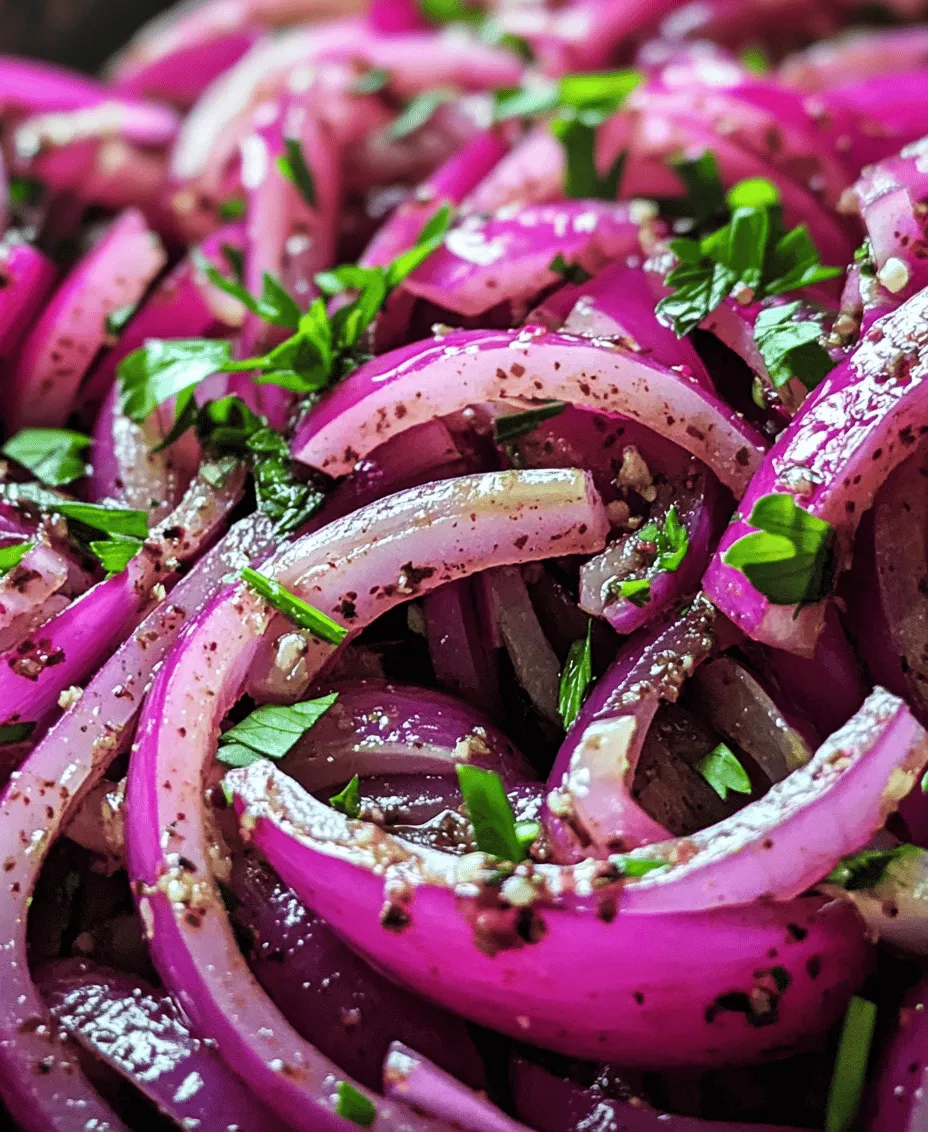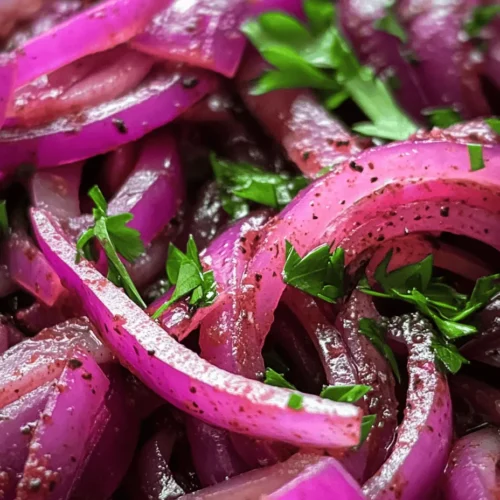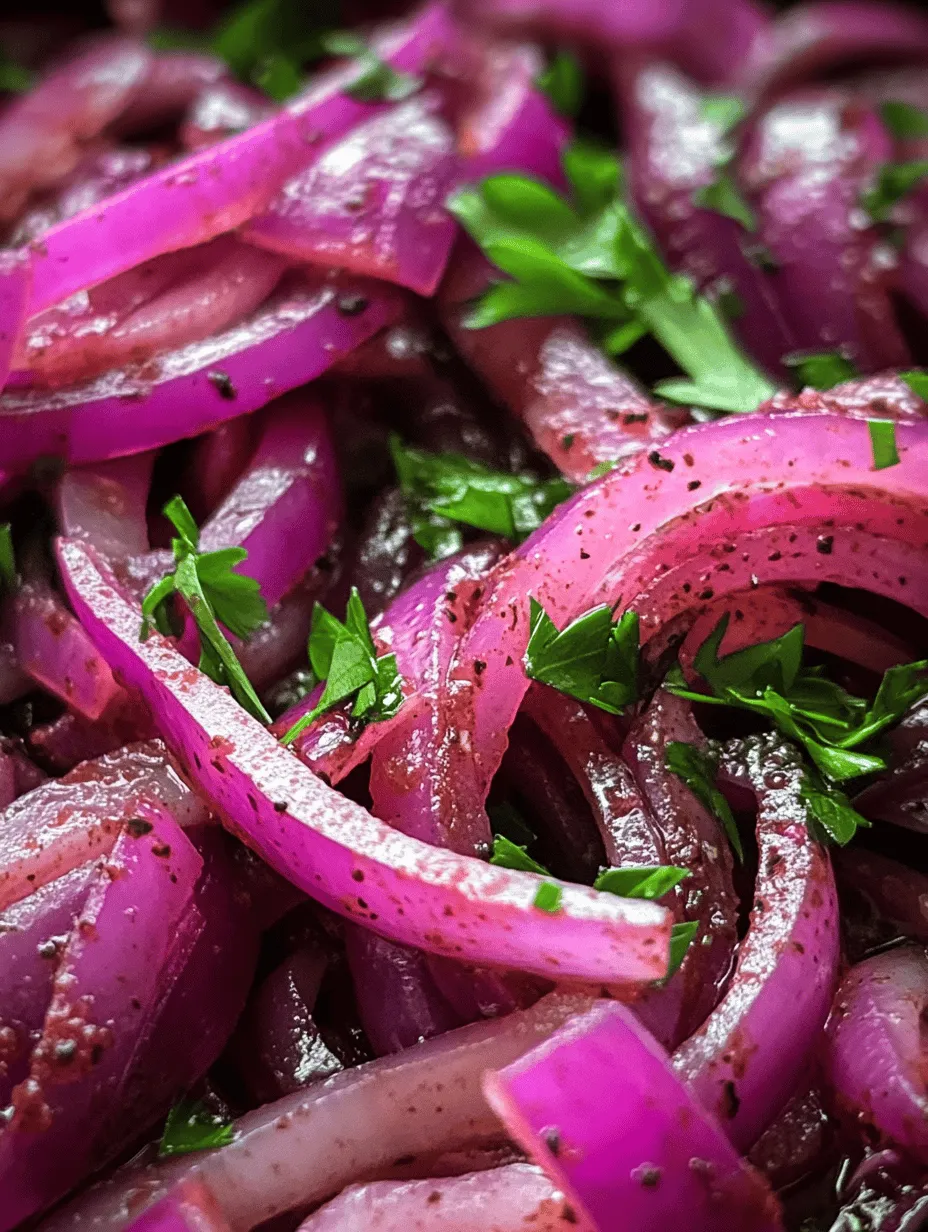In the world of culinary exploration, few ingredients possess the versatility and unique flavor profile of sumac. With its tangy, citrusy essence, sumac is the star of our featured recipe: Sumac Onions Delight. This vibrant dish not only serves as a delightful accompaniment to any meal but also stands out as a healthy option packed with flavor. In this article, we will dive into the rich history and benefits of sumac, explore the significance of red onions in cuisine, and provide a detailed recipe that will elevate your dining experience.
Understanding Sumac: A Culinary Gem
Exploring the Origins of Sumac
Sumac is derived from the dried and ground berries of the sumac plant, which belongs to the Anacardiaceae family. Its use dates back thousands of years and is deeply rooted in the culinary traditions of the Middle East and Mediterranean regions. Ancient civilizations recognized sumac not only for its flavor but also for its preservative qualities, often using it to add a zesty kick to meat dishes. In modern kitchens, sumac has gained popularity for its ability to elevate salads, dips, and roasted vegetables.
Nutritionally speaking, sumac is packed with benefits. It’s rich in antioxidants, which play a critical role in protecting the body from oxidative stress. Additionally, sumac has anti-inflammatory properties and is known to aid in digestion. This makes it not just a flavorful addition to your meals, but a health-conscious choice as well.
Culinary Uses of Sumac
Sumac is incredibly versatile in the kitchen. It serves as an excellent seasoning for meats and vegetables, lending a bright, tangy flavor that can transform even the simplest of dishes. When sprinkled over grilled chicken or fish, it enhances the natural flavors while adding a unique twist. In salads, sumac not only elevates the taste but also adds a pop of color, making your dish visually appealing. Dips such as hummus or baba ghanoush benefit immensely from the addition of sumac, providing a refreshing contrast to creamy textures.
Moreover, sumac plays a vital role in traditional dishes, particularly in Middle Eastern cuisine. It is a key ingredient in the famous spice blend za’atar, which combines sumac with thyme, sesame seeds, and salt. This blend is often used to season bread, meats, and vegetables, showcasing the versatility of sumac in both everyday meals and festive occasions.
The Role of Red Onions in Cooking
Nutritional Benefits of Red Onions
Red onions, with their striking color and sweet flavor, are a staple in many kitchens around the world. They are rich in antioxidants, particularly quercetin, which is known for its anti-inflammatory and immune-boosting properties. This makes red onions not just a flavor enhancer but also a valuable contributor to your overall health. Regular consumption of red onions can support heart health, improve blood sugar levels, and even aid in digestion.
In addition to antioxidants, red onions are a good source of essential vitamins such as vitamin C and vitamin B6. These nutrients play crucial roles in maintaining skin health, boosting the immune system, and supporting metabolic functions. Incorporating red onions into your diet can contribute to overall wellness while adding depth and complexity to your meals.
Culinary Versatility of Red Onions
One of the key distinctions between red, yellow, and white onions lies in their flavor profile. Red onions are known for their mild, sweet taste, which becomes even sweeter when cooked. This makes them ideal for salads, salsas, and pickling. Their vibrant color not only enhances the visual appeal of dishes but also indicates their rich antioxidant content.
When using red onions in cooking, they can be enjoyed raw, grilled, roasted, or caramelized. Their versatility allows them to complement a wide range of dishes, from meat and fish to vegetarian meals. In our recipe for Sumac Onions Delight, the red onions contribute a crunchy texture and a sweet yet slightly tangy flavor that pairs beautifully with the bright notes of sumac.
Ingredients Breakdown for Sumac Onions Delight
To create the perfect Sumac Onions Delight, it’s essential to focus on the quality and freshness of each ingredient. Here’s a breakdown of what you will need:
Highlighting Each Ingredient
1. Fresh Red Onions: The star of the dish, fresh red onions provide a crunchy texture and a sweet flavor that balances the tanginess of sumac. When selecting red onions, look for firm bulbs with smooth skin, avoiding any that show signs of sprouting or blemishes.
2. Olive Oil: As a healthy fat, olive oil adds richness to the dish while enhancing the flavors of the other ingredients. It is packed with heart-healthy monounsaturated fats and antioxidants, making it a staple in Mediterranean cuisine. Opt for extra virgin olive oil for the best flavor and quality.
3. Apple Cider Vinegar: This ingredient plays a crucial role in balancing the flavors of the dish. The acidity of apple cider vinegar brightens the overall taste and complements the sweetness of the red onions. Additionally, apple cider vinegar has been linked to various health benefits, including improved digestion and blood sugar regulation.
4. Honey or Agave Syrup: To add a touch of sweetness to the dish, honey or agave syrup can be used. This sweetness counteracts the tanginess of the sumac and vinegar, creating a harmonious flavor profile. Choose raw honey for a more natural option, or agave syrup for a vegan-friendly alternative.
5. Salt and Pepper: These essential seasoning ingredients help to enhance the flavors of the dish. Use kosher salt for a more balanced taste and freshly cracked black pepper to add a hint of spice.
6. Fresh Parsley: The finishing touch to our Sumac Onions Delight is fresh parsley. This vibrant herb not only adds a pop of color but also contributes a fresh, earthy flavor that complements the dish. When selecting parsley, look for bright green leaves that are free from yellowing or wilting.
With these ingredients in hand, you are well on your way to creating a delicious and vibrant Sumac Onions Delight that will impress your guests and elevate your meals.
—
Stay tuned for the next part of the article, where we will delve into the step-by-step instructions for preparing this delightful dish, along with tips for achieving the best results.

Step-by-Step Guide to Making Sumac Onions Delight
Creating Sumac Onions Delight is a straightforward yet rewarding culinary experience. This dish perfectly balances the tangy flavor of sumac with the crispness of fresh onions, making it a refreshing addition to any meal. Below, we’ll delve into the preparation of ingredients, marinating processes, and final presentation tips to ensure your dish is as delightful as it sounds.
Preparation of Ingredients
Tips for Slicing Onions Thinly for Optimal Texture
To achieve the best texture for your Sumac Onions Delight, slicing the onions thinly is crucial. Here are some tips to help you with the slicing process:
1. Choose the Right Knife: A sharp chef’s knife is essential for clean, smooth cuts. Dull knives can bruise the onions, leading to a less appealing texture.
2. Chill the Onions: If you find that slicing onions makes your eyes water, try chilling them in the refrigerator for about 30 minutes before cutting. This can help reduce the release of irritating sulfur compounds.
3. Cutting Technique: Start by cutting off the ends of the onion and peeling away the outer layer. Place the onion flat on your cutting board, slice it in half from root to tip, and then lay each half cut side down. This position provides stability and allows for thin, even slices.
4. Aim for Uniformity: Try to keep the slices around 1/8 inch thick. Uniform slices will marinate evenly and provide a pleasing mouthfeel.
How to Prepare the Dressing for Maximum Flavor Infusion
The dressing is where the flavor of your Sumac Onions Delight truly shines. A well-balanced dressing enhances the onions and allows the unique flavors to meld beautifully. Follow these steps:
1. Ingredients for the Dressing: Use high-quality extra virgin olive oil, fresh lemon juice, sumac, salt, and a pinch of black pepper. You may also consider adding a touch of honey or maple syrup for balance if you prefer a hint of sweetness.
2. Mixing the Dressing: In a small mixing bowl, whisk together 3 tablespoons of olive oil, the juice of one lemon (about 2 tablespoons), 1 teaspoon of sumac, and salt and pepper to taste. Whisk until well combined; the olive oil should emulsify with the lemon juice.
3. Infusion: For a deeper flavor, allow the dressing to sit for at least 10 minutes before adding it to the onions. This resting time allows the flavors to meld.
Marinating Process
Importance of Marinating Time for Flavor Development
Marinating is a crucial step for ensuring that the onions absorb the full flavor of the dressing. Here are some insights into the marinating process:
1. Timing: Ideally, let the onions marinate for at least 30 minutes. This duration allows the acidity from the lemon juice to slightly soften the onions while the sumac infuses its tangy flavor.
2. Flavor Depth: For an even richer taste, consider marinating for up to 2 hours. The longer the onions sit, the more pronounced the flavors become.
Techniques for Ensuring Even Coating of the Dressing
To ensure that every slice of onion is evenly coated with the dressing, follow these techniques:
1. Tossing Method: After slicing the onions, place them in a large bowl and drizzle the dressing over the top. Use your hands or a spatula to gently toss the onions until they are well coated. Avoid crushing the slices; you want them to remain intact.
2. Use a Zip-Lock Bag: Alternatively, you can place the sliced onions and dressing in a resealable plastic bag. Seal the bag and gently shake to distribute the dressing evenly. This method is particularly helpful if you are marinating the onions for an extended period.
3. Check for Coating: After tossing, take a moment to check that all onion slices have a nice glisten from the dressing. If some slices appear dry, add a little more dressing and toss again.
Final Presentation
Serving Suggestions for Aesthetic Appeal
The presentation of your Sumac Onions Delight can elevate the dining experience. Here are some ideas:
1. Serve in a Beautiful Bowl: Choose a shallow, wide bowl to showcase the vibrant colors of the dish. The contrast of the red onions and the green of the parsley will be visually appealing.
2. Garnish with Fresh Herbs: Just before serving, sprinkle freshly chopped parsley or mint on top. This not only adds a pop of color but also enhances the freshness of the dish.
3. Add a Lemon Wedge: Present the dish with a lemon wedge on the side. This allows guests to add a little extra acidity if desired and adds an inviting touch.
Ideas for Pairing with Different Dishes
Sumac Onions Delight can be a versatile accompaniment to many meals. Consider these pairing ideas:
1. Middle Eastern Dishes: Serve it alongside grilled meats such as kebabs or shawarma. The tanginess of the onions complements the savory flavors of the meat beautifully.
2. Mediterranean Bowls: Use it as a topping for grain bowls featuring quinoa, couscous, or rice, along with roasted vegetables and a protein source like chickpeas or grilled chicken.
3. Tacos and Wraps: Incorporate Sumac Onions Delight into your favorite tacos or wraps for an added layer of flavor. It pairs well with fish, chicken, or even roasted vegetables in tortilla wraps.
The Health Benefits of Sumac Onions Delight
This dish is not only flavorful but also packed with health benefits. Let’s explore the nutritional aspects of Sumac Onions Delight.
Nutritional Analysis of the Recipe
Breakdown of Calories and Macronutrients per Serving
A typical serving of Sumac Onions Delight (approximately 1/2 cup) contains the following nutritional profile:
– Calories: 70
– Carbohydrates: 7g
– Fat: 4g
– Protein: 1g
– Fiber: 2g
This simple salad is low in calories but high in flavor, making it a great option for those looking to add healthy sides to their meals.
Health Benefits of Consuming This Dish Regularly
1. Rich in Antioxidants: Red onions are rich in antioxidants, particularly quercetin, which helps combat oxidative stress in the body.
2. Digestive Health: The fiber content in onions supports digestive health and can aid in maintaining a healthy gut.
3. Anti-Inflammatory Properties: Sumac contains anti-inflammatory properties and has been traditionally used to lower blood pressure and improve heart health.
How It Fits into a Healthy Diet
Incorporating This Recipe into Various Dietary Preferences
Sumac Onions Delight is a fantastic addition to various dietary lifestyles, including:
1. Vegan and Vegetarian: This dish is completely plant-based, making it a great choice for anyone following a vegan or vegetarian diet.
2. Gluten-Free: Sumac Onions Delight is naturally gluten-free, ensuring that it can be enjoyed by those with gluten sensitivities.
3. Low-Calorie Diets: Its low-calorie count makes it a suitable option for those looking to manage their weight while still enjoying flavorful meals.
Balancing Flavors and Nutrients in Meals
To create a well-rounded meal, pair Sumac Onions Delight with protein sources such as grilled chicken, fish, or legumes. This combination not only balances flavors but also ensures a good intake of essential nutrients, contributing to overall health.
Sumac Onions Delight in Different Cuisines
Inspiration from Middle Eastern Cuisine
Traditional Dishes Featuring Sumac and Onions
Sumac is a staple in many Middle Eastern cuisines, often used to enhance the flavors of dishes. Sumac Onions Delight draws inspiration from:
1. Fattoush: A traditional Lebanese salad that features sumac, fresh vegetables, and crispy pita bread.
2. Shawarma: Commonly served with shawarma, sumac onions provide a refreshing contrast to the rich, spiced meat.
3. Tabbouleh: Another popular salad that often incorporates sumac along with parsley, tomatoes, and bulgur.
How to Adapt This Recipe to Fit Various Culinary Styles
Feel free to adapt the basic recipe to fit your favorite dishes. For instance, try adding diced tomatoes or cucumbers for a more traditional Middle Eastern salad, or mix in some feta cheese for a Mediterranean twist.
Fusion Ideas with Other Cuisines
Creative Ways to Incorporate Sumac Onions Delight into Diverse Meals
Think outside the box and explore unique pairings:
1. Asian-Inspired Bowls: Add Sumac Onions Delight to rice bowls with grilled chicken or tofu, along with sesame seeds and edamame for an Asian flair.
2. Tacos with a Twist: Use the onions as a zesty topping for fish or shrimp tacos, combining the flavors of lime and cilantro.
3. Pasta Salad: Incorporate the dish into a cold pasta salad, mixing it with whole wheat pasta, olives, and roasted peppers for a Mediterranean-inspired meal.
Pairing with International Dishes for Unique Flavor Combinations
Experimenting with flavors can lead to exciting culinary discoveries. Consider pairing Sumac Onions Delight with:
1. Curry Dishes: The tangy flavor can cut through the richness of curry, providing a refreshing contrast.
2. Barbecue: Use it as a vibrant side for grilled meats, enhancing the smoky flavors of barbecue.
3. Pizza Topping: Add it to flatbreads or pizzas for a burst of freshness that complements savory toppings.
Conclusion: Embracing Flavor with Sumac Onions Delight
In conclusion, Sumac Onions Delight is not just a simple salad; it is a celebration of flavors, health, and culinary traditions. This dish showcases how a few quality ingredients can come together to create something truly special. Whether enjoyed as a side dish at a family gathering or as a refreshing topping for your favorite meal, this recipe is sure to impress.
By understanding the ingredients and the process behind it, you can appreciate the beauty of cooking and the joy it brings to our tables. Embrace the flavors of sumac and red onions, and let this delightful dish inspire your culinary journey.


